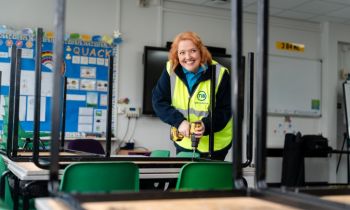When I first became a teacher back in 1993, I’d teach using a blackboard. These were graphic design lessons, with 30 kids in the classroom, which would involve isometric drawing, where the children would be required to follow lines and instructions laid out on the blackboard one stage at a time. It was a difficult thing to achieve.
From there, we moved to using OHPs and whiteboards, and eventually transitioned to interactive whiteboards in the early 2000s. I remember our first one – at the time I was a young head of department at a brand new school, and duly put it in our biggest and shiniest classroom. From around 2008 onwards we then started seeing a shift to using wall-mounted projectors – but through all those changes, not once did I consider how the size and positioning of the screen might have implications for pupils’ learning.
Troubling findings
Research conducted by Epson with over 300 teachers across different settings has shown that 40% perceive a correlation between children being unable to clearly see a screen and lower test scores. Epson published that statistic and others in a report that uses the term ‘cheap seats’ to describe the phenomenon – which I find quite troubling.
I’ve given lots of thought to where my pupils are seated, of course, but never to how the impact of the visuals I’m using will vary as a result.
I’ve been very active on social media over the last 10 years, partly because of how it’s helped me access educational research much more quickly, and become more immersed in fields like cognitive science. We’re still working out how our brains enable us to learn as adults, and the ways in which we can struggle to retain information. How tough must that process be for a seven-year-old, when you can’t even comprehend or articulate what’s happening to you in class?
Impact on learning
I need to check with my learners to see whether they know what I’ve asked them to do and can comprehend the information I’m teaching them. One of the easiest ways for a teacher with a class of 30 pupils to navigate this is to quiz – ‘How do you spell ‘volcano?’ Hands may be raised, answers could be written on mini whiteboards.
But how should that question be conveyed via a screen? We might display the text of the question – ideally not at a miniscule size – alongside a nice, big picture of a volcano. If I also say the question out loud, I’ve given the pupils three ways of accessing the information. If 12 hands go up, I can then evaluate what to do next.
If I fail to check what the kids can see and read quickly or effectively enough, that’s going to have a big impact on how they learn – and as the aforementioned research shows, their educational outcomes, behaviour, engagement and participation in class.
Time constraints
Good quality teaching will often utilise dual coding – I’ll show a picture of a volcano on the screen, followed by slide with the word ‘volcano’ written in a large font. Meanwhile, there may be a pupil in the corner who’s visually impaired, completing a worksheet on which the vowels of the word are missing so they can learn how to spell it.
Primary teachers have got various ‘ins’, but will need to prepare, plan, rehearse and test them in the context of multiple subjects that will be taught to 30 kids at a time. Teachers and school leaders therefore have very little time to spend on assessing the learning impact of a particular item of edtech and how it should be used.
In my own experience, I’ve not had the time to immerse myself in this sort of information. I think back to the projectors I’ve used over the years, and how the school would often purchase one device and install it in every classroom. A company might customise each projector’s location and distance, but these were secondary school classrooms. A maths teacher might be using theirs to write equations on a screen; as a D&T teacher, my screen would be located in a much larger classroom with machinery and workshop areas – yet there would be little differentiation in terms of the visuals seen by students.
That’s the reality in many schools, because we’re not experts. We rely on companies like Epson and others to provide us with research and expertise. I’ve visited well over a hundred schools, and from what I’ve seen, primary schools largely operate with interactive whiteboards, while secondaries will use a mix of whiteboards, touchscreens, projectors, and interactive boards that vary in size and scale according to department, room size and many other factors.
Context is key
The headline features of one device or display won’t apply in every situation, so what I’d say to edtech companies is that their products have to be both affordable and offer a long-term solution. The former can be addressed through site licences and other ways of covering costs that are more affordable over time, rather than large, one-off purchases. The latter should entail more in the way of support than ‘There’s your product, here’s the support number, see you later.’ Someone should be able to attend the site where the equipment will be used in order to check, test and if necessary, update it.
Teachers also need training, but with the current high stakes accountability system through league tables and exam performance, schools won’t typically use their Inset days in a way that lets teachers learn more about using classroom screens and displays. Even if they do, it’ll usually be to show how a brand new product woks, and the content will rarely be revisited.
We could start addressing the ‘cheap seats’ issue by giving schools access to online materials – perhaps a 10-minute training video that highlights recent edtech impact research, graphics that clearly show how the 4/6/8 rule applies to classrooms (see below), short presentations – information that schools would value.
Among the people I’ve worked with, I’ve rarely encountered considerations of where screens are positioned, whether the 4/6/8 rule has been observed or if we risk cognitive overload through the way we present photographs and decide on the size and colour of text. For all we know, that seven-year-old child at the back can’t decode the information we’re providing.
We all have different sensory needs, and the challenge teachers face in having to meet those needs can be highly complex. We’re still working out how the process of learning works, which directly applies to how we use our projectors, how our classrooms are arranged, where the kids are sitting and how our lessons are taught. What edtech companies can do is support teachers in using their tools in the most effective way possible.
The 4/6/8 rule
To determine how large the screens in shared rooms, lecture halls and other public spaces should be, audiovisual specialists will use the 4/6/8 rule. This rule holds that ideal viewing distance, in correlation with room size, should be 4, 6 or 8 times the height of the screen for analytical viewing, basic viewing and passive viewing respectively.
Ross McGill is a teacher, author, speaker and the director of TeacherToolkit.









